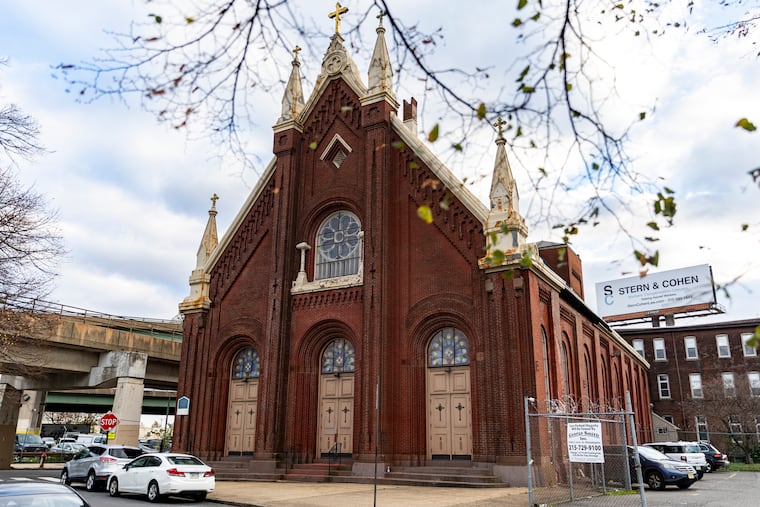A former Catholic church in Northern Liberties is slated for apartments
Developer Ori Feibush is planning apartments within a historic Northern Liberties church, and using preservation incentives to smooth the way.

In Northern Liberties, a recently shuttered Catholic church could soon be transformed into an apartment building.
The Immaculate Conception Church, on Front Street next to the Market-Frankford elevated track, is more than 150 years old. It is built of red brick and brownstone and was erected to serve Philadelphia’s substantial and growing 19th-century Irish population. It is on the city’s register of historic places, so it is protected from demolition.
Developer Ori Feibush purchased the church, along with its neighboring and similarly protected rectory, this past summer. He plans a 45-apartment building, which will be adjacent to a townhome development he is planning on the site of the former Vesper Dayclub.
“We’re looking to build very inexpensive apartments here,” said Feibush, president and founder of OCF Realty. “There’s no doorman, no gym. They are nice, clean units, but tenants aren’t paying for any frills.”
Once a largely industrial area laced with worker housing, Northern Liberties began to see an influx of artists in the 1980s and 1990s. Redevelopment followed and the neighborhood has long been a symbol of Philadelphia’s revitalized fortunes in the 21st century.
During the pandemic, however, development became turbocharged and large real estate interests like the Post Brothers invested heavily in this corner of the city. The target demographics of these newer projects are upwardly mobile professionals and their families.
“We’re building a product that’s largely inconsistent with much of what’s getting developed in the mid-rises and larger, more amenitized buildings that are going up in Northern Liberties,” said Feibush.
The church is zoned for single-family residential, which would normally complicate the project. But in 2019, City Council passed a package of incentives for the redevelopment of historically protected buildings. Feibush says this will allow him to move forward on the multifamily project without relief from the Zoning Board of Adjustment.
But Feibush is petitioning the Historical Commission to allow him to make some changes to the exterior of the building. He wants to replace the slate roof with faux slate tiles and add dormers to get more light into the interior of the building.
“The building is in good shape, but the roof structure is in pretty bad shape,” said Feibush. “The goal is to find some middle ground where we’re protecting the integrity of the building, while still modernizing in such a way that we can accommodate apartments.”
The first step in Feibush’s efforts will take place on Nov. 22, when the advisory Architectural Committee will review his request. Then the full Historical Commission will rule on his petition, possibly as soon as their December meeting.
Feibush said he did not anticipate neighborhood backlash to the project. But a recent effort to turn a similarly retired Catholic church, St. Laurentius, into an apartment building in Fishtown sparked a lengthy legal conflict in the neighborhood.
Opponents claimed that they did not want to see their old church turned into market rate housing, while others complained about a lack of parking. In the end, the beloved neighborhood icon was demolished as a result of the turmoil.
There are key distinctions between the projects, however. Fishtown has seen more tumult in recent years between newer inhabitants and the neighborhood’s working-class residents, whereas Northern Liberties had a small incumbent population before its artist-led revival. The St. Laurentius conversion also did not include parking, which is less of an issue at this site. The Fishtown drama also largely unfolded before City Council passed its zoning incentives for historic buildings.
Longtime neighborhood activist and resident Matt Ruben says that he doesn’t believe many in the neighborhood know about the conversion plan yet, and wouldn’t hazard a guess as to what the reaction might be.
“My perception is that the importance of saving historic buildings has a much stronger consensus behind it than the question of what you do with it once it’s saved,” said Ruben.
Feibush said that parking may not be as much of a concern here because his neighboring townhome project will include 36 homes and 72 parking spaces on a site where he could have built four times as much housing. There will also be a 16-space parking lot next to the church.
“On this project there’s not going to be as much frustration because we’ll be building much less density directly abutting this, with way more parking,” said Feibush.
Feibush intends to break ground on the townhomes in the next month or two. The apartment project’s timeline will be determined by the Historical Commission’s ruling, and if he isn’t able to get their approval he says he may attempt to sell the structure.